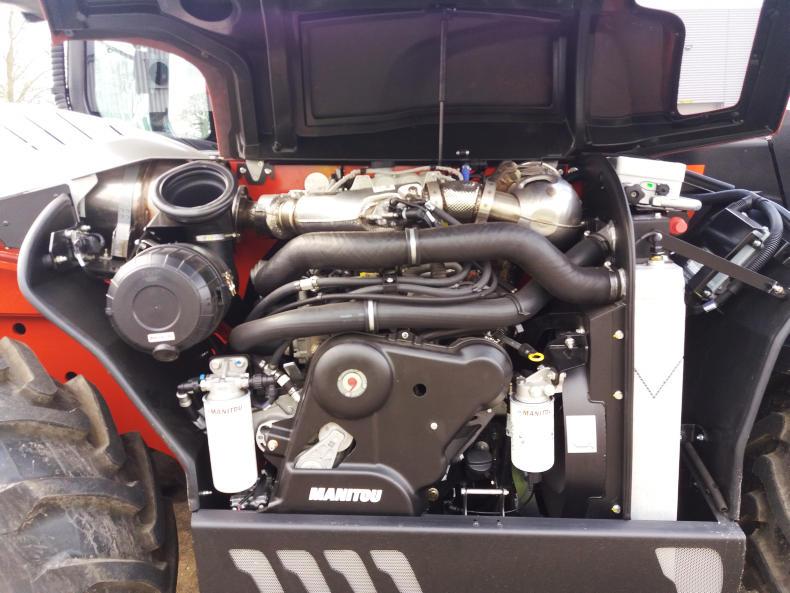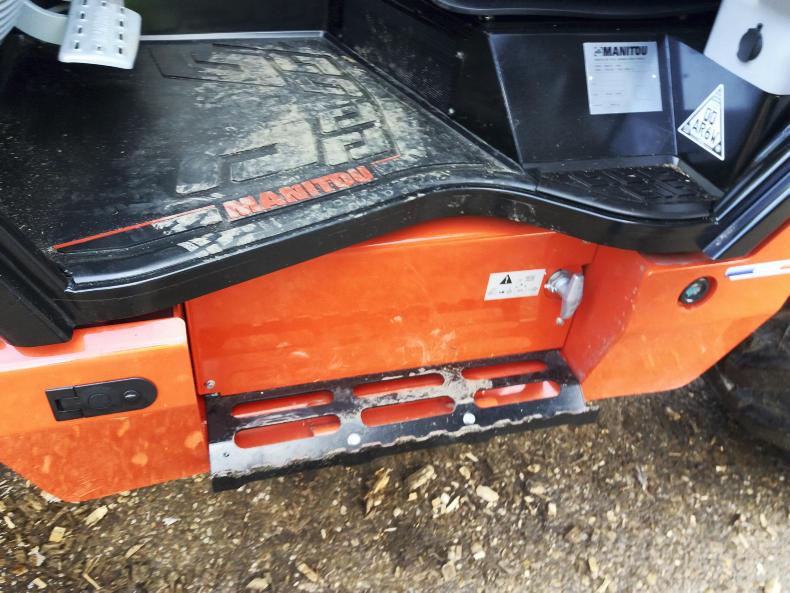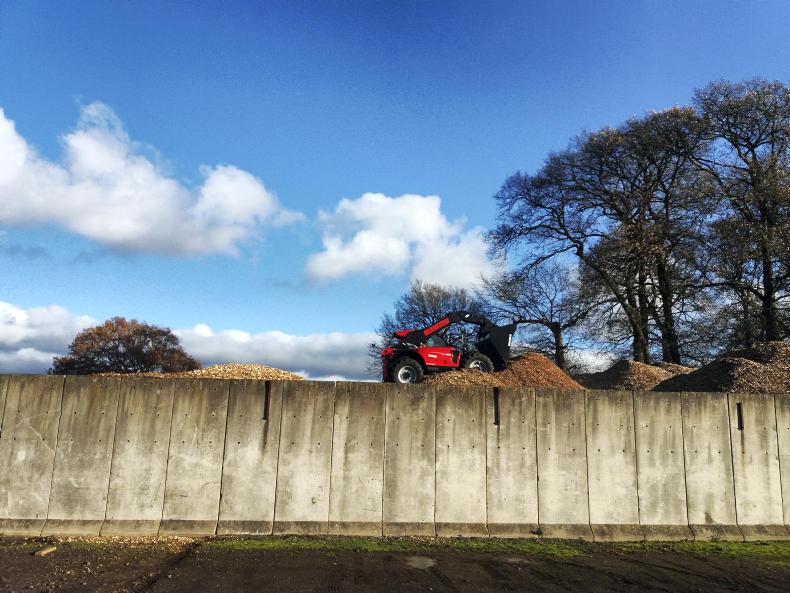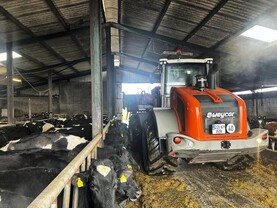Stoneleigh Park, former home of the Royal Show, was the venue chosen to give the media the opportunity to see the latest updates to Manitou’s telescopic loaders.
The French manufacturer’s machines have a good reputation for reliability and quality so any update had to at least meet or exceed the company’s reputational build quality.
The same but different
In the MLT 630 range, there are three loaders all with the same chassis, boom and cab. The difference between them is the position of the cab relative to the chassis, meaning a difference in overall height from 2.14m up to 2.37m.

Engine access was good thanks to the one-piece bonnet.
They are all fitted with the same 3.6l Deutz engine that puts out 101hp which uses a DOC (diesel oxidation catalyst) valve and an SCR (selective catalytic reduction) catalytic converter to meet emission standards in combination with Ad-Blue. All loaders are fitted with a 40km/h transmission.
In the three-model line-up, there are three finish levels available – classic, premium and elite, with various loader options available in all three finishes. The other difference between these machines is the wheel size which ranges from 20in on the smaller models up to 24in on the larger model, depending on customer preference.
To add even more choice to these loaders, there are three transmission options in this range. A customer can choose from hydrostatic, torque converter or, unusually, a continuously variable transmission. And if one of these three loaders does not meet a customer’s requirements, there are a further six different loaders to choose from the “New-Ag” range as Manitou are calling it. Lift capacity across the range is from 3t to 4.1t.
Stepping up
Sitting into the cab, two simple things I noticed really make cab access easier. A curved notch has been taken out of the cab floor so it’s easier to put your foot on to the cab step.
So simple but clever. The other is the hand rail that moves with the door – it’s easily reached when the door is opened and tucks out of the way of your left elbow when the door is closed.

A simple yet cleaver design makes getting in and out of the cab easier.
Interestingly, Manitou loaders all come with a one-piece door and a window that can be opened.
Manitou says the advantage is the operator can still have fresh air flowing into the cab without the door opened, which could potentially get damaged. In the cab, the view is clear and unobstructed in all directions. The extended windscreen both down towards the wheels and up over the driver’s head gives plenty of view. There is a large wiper that covers a lot of the glass.
Manitou has even patented the external safety roof grill which serves its purpose without obstructing the view of the boom when it is raised. All panes of glass, apart from that over my left shoulder, can be fitted with a wiper and air conditioning is standard across nearly all models.
Losing control
Coming from a farm where loaders of a different colour are used, the first thing I noticed missing was the left-hand reverser. Direction change and most other functions are controlled from the right-hand side-mounted loader control lever, apart from the most basic of machines.
This fit very comfortably into my hand with a small red switch for changing direction. Three different transmission options are available, depending on machine specification. The torque converter gearbox can be controlled from a dedicated manual gear lever with button-clutch or from the -/+ switch on the loader control lever. Forward and reverse is still from the small red switch on the same lever.
The hydrostatic option is also controlled from the same place with a dash-mounted switch for range selection. Lastly, the CVT (continuously variable transmission) option, M-Vario Plus uses two hydraulic motors with radial pistons powered by a hydraulic pump. At low speeds, two motors are active for added pushing power, which Manitou says is comparable with that of a torque converter transmission. At high speeds, just one motor is active to save fuel when not as much power is needed on road duties, for example.
From all the information I heard, there was a transmission for every application which Manitou was keen to stress. A lot of thought was put into this cab and even the option to move switches is another Manitou idea.

If an operator wants to move a switch from the dash to beside the loader control lever, they can, and the functionality stays with the switch – not the location of it. This is known as the DSB (Double Switch Button) and operates thanks to the CAN BUS system.
Loader maintenance made easy
Walking around the loader, we noticed a few cleaver ideas. Banked grease points at the rear of the loader for the rear axle mean they’re more likely to be greased. On the rear mudguards, two grease points on the inside of the bracket are easily accessible, making the unenviable job of greasing the axle ends easier. Engine bay access is good, with a large one-piece bonnet giving plenty of room to get at all the most important parts.
There is even a short length of hose on the machine that can be added to the sump plug when it comes to changing the oil to get the waste oil into the tray and not spill on the ground.
A reversible fan runs for 15 seconds every three minutes.
Watching the loaders working in the pile of woodchip, we got to see how the regenerative hydraulics worked, which Manitou says saves 5% on fuel. When the boom is lowered, oil flow is diverted to other parts of the machine such as retracting the boom making cycle times quicker.
QuickLift raises the boom vertically as opposed to in an arc. Hydraulic oil flow is from 104 to 170l/min depending on model.
Read more
Krone crowned king at machine of the year
TMR – what does it mean and how will it affect tractors?
Stoneleigh Park, former home of the Royal Show, was the venue chosen to give the media the opportunity to see the latest updates to Manitou’s telescopic loaders.
The French manufacturer’s machines have a good reputation for reliability and quality so any update had to at least meet or exceed the company’s reputational build quality.
The same but different
In the MLT 630 range, there are three loaders all with the same chassis, boom and cab. The difference between them is the position of the cab relative to the chassis, meaning a difference in overall height from 2.14m up to 2.37m.

Engine access was good thanks to the one-piece bonnet.
They are all fitted with the same 3.6l Deutz engine that puts out 101hp which uses a DOC (diesel oxidation catalyst) valve and an SCR (selective catalytic reduction) catalytic converter to meet emission standards in combination with Ad-Blue. All loaders are fitted with a 40km/h transmission.
In the three-model line-up, there are three finish levels available – classic, premium and elite, with various loader options available in all three finishes. The other difference between these machines is the wheel size which ranges from 20in on the smaller models up to 24in on the larger model, depending on customer preference.
To add even more choice to these loaders, there are three transmission options in this range. A customer can choose from hydrostatic, torque converter or, unusually, a continuously variable transmission. And if one of these three loaders does not meet a customer’s requirements, there are a further six different loaders to choose from the “New-Ag” range as Manitou are calling it. Lift capacity across the range is from 3t to 4.1t.
Stepping up
Sitting into the cab, two simple things I noticed really make cab access easier. A curved notch has been taken out of the cab floor so it’s easier to put your foot on to the cab step.
So simple but clever. The other is the hand rail that moves with the door – it’s easily reached when the door is opened and tucks out of the way of your left elbow when the door is closed.

A simple yet cleaver design makes getting in and out of the cab easier.
Interestingly, Manitou loaders all come with a one-piece door and a window that can be opened.
Manitou says the advantage is the operator can still have fresh air flowing into the cab without the door opened, which could potentially get damaged. In the cab, the view is clear and unobstructed in all directions. The extended windscreen both down towards the wheels and up over the driver’s head gives plenty of view. There is a large wiper that covers a lot of the glass.
Manitou has even patented the external safety roof grill which serves its purpose without obstructing the view of the boom when it is raised. All panes of glass, apart from that over my left shoulder, can be fitted with a wiper and air conditioning is standard across nearly all models.
Losing control
Coming from a farm where loaders of a different colour are used, the first thing I noticed missing was the left-hand reverser. Direction change and most other functions are controlled from the right-hand side-mounted loader control lever, apart from the most basic of machines.
This fit very comfortably into my hand with a small red switch for changing direction. Three different transmission options are available, depending on machine specification. The torque converter gearbox can be controlled from a dedicated manual gear lever with button-clutch or from the -/+ switch on the loader control lever. Forward and reverse is still from the small red switch on the same lever.
The hydrostatic option is also controlled from the same place with a dash-mounted switch for range selection. Lastly, the CVT (continuously variable transmission) option, M-Vario Plus uses two hydraulic motors with radial pistons powered by a hydraulic pump. At low speeds, two motors are active for added pushing power, which Manitou says is comparable with that of a torque converter transmission. At high speeds, just one motor is active to save fuel when not as much power is needed on road duties, for example.
From all the information I heard, there was a transmission for every application which Manitou was keen to stress. A lot of thought was put into this cab and even the option to move switches is another Manitou idea.

If an operator wants to move a switch from the dash to beside the loader control lever, they can, and the functionality stays with the switch – not the location of it. This is known as the DSB (Double Switch Button) and operates thanks to the CAN BUS system.
Loader maintenance made easy
Walking around the loader, we noticed a few cleaver ideas. Banked grease points at the rear of the loader for the rear axle mean they’re more likely to be greased. On the rear mudguards, two grease points on the inside of the bracket are easily accessible, making the unenviable job of greasing the axle ends easier. Engine bay access is good, with a large one-piece bonnet giving plenty of room to get at all the most important parts.
There is even a short length of hose on the machine that can be added to the sump plug when it comes to changing the oil to get the waste oil into the tray and not spill on the ground.
A reversible fan runs for 15 seconds every three minutes.
Watching the loaders working in the pile of woodchip, we got to see how the regenerative hydraulics worked, which Manitou says saves 5% on fuel. When the boom is lowered, oil flow is diverted to other parts of the machine such as retracting the boom making cycle times quicker.
QuickLift raises the boom vertically as opposed to in an arc. Hydraulic oil flow is from 104 to 170l/min depending on model.
Read more
Krone crowned king at machine of the year
TMR – what does it mean and how will it affect tractors?









 This is a subscriber-only article
This is a subscriber-only article


























SHARING OPTIONS: